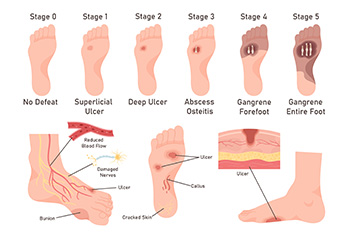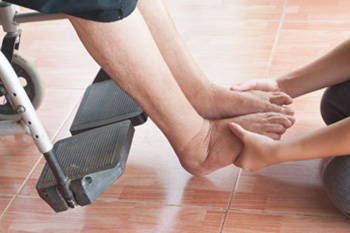Items filtered by date: May 2025
Do Your Child's Feet Hurt?
Stages of Pressure Ulcers and How to Care for Them

Pressure ulcers are skin wounds caused by prolonged pressure, commonly forming on the feet in those individuals with restricted mobility or circulation problems. These ulcers progress through four stages. Stage 1 appears as red or discolored skin that does not blanch when pressed. Stage 2 involves partial skin loss with a shallow open sore or blister. Stage 3 is marked by deeper tissue loss, possibly exposing fat. Stage 4 is the most severe, showing extensive damage to muscle, bone, or tendons. Early detection is critical at any stage. Reducing pressure with offloading devices, keeping the wound clean, and managing underlying conditions like diabetes are essential parts of care. Avoiding further irritation and maintaining overall skin health can prevent progression. If you observe skin changes or suspect an ulcer may be developing on your foot, it is suggested that you visit a podiatrist for accurate diagnosis and personalized treatment.
Wound care is an important part in dealing with diabetes. If you have diabetes and a foot wound or would like more information about wound care for diabetics, consult with Kenneth Williams, DPM from Texas. Our doctor will assess your condition and provide you with quality foot and ankle treatment.
What Is Wound Care?
Wound care is the practice of taking proper care of a wound. This can range from the smallest to the largest of wounds. While everyone can benefit from proper wound care, it is much more important for diabetics. Diabetics often suffer from poor blood circulation which causes wounds to heal much slower than they would in a non-diabetic.
What Is the Importance of Wound Care?
While it may not seem apparent with small ulcers on the foot, for diabetics, any size ulcer can become infected. Diabetics often also suffer from neuropathy, or nerve loss. This means they might not even feel when they have an ulcer on their foot. If the wound becomes severely infected, amputation may be necessary. Therefore, it is of the upmost importance to properly care for any and all foot wounds.
How to Care for Wounds
The best way to care for foot wounds is to prevent them. For diabetics, this means daily inspections of the feet for any signs of abnormalities or ulcers. It is also recommended to see a podiatrist several times a year for a foot inspection. If you do have an ulcer, run the wound under water to clear dirt from the wound; then apply antibiotic ointment to the wound and cover with a bandage. Bandages should be changed daily and keeping pressure off the wound is smart. It is advised to see a podiatrist, who can keep an eye on it.
If you have any questions please contact our office located in San Antonio and Beeville, TX . We offer the newest diagnostic and treatment technologies for all your foot and ankle needs.
Treatment Options for a Torn Ankle Ligament

An ankle sprain often involves a torn ligament, which can cause swelling, pain, and instability in the joint. Ankle sprains usually occur when the foot twists or rolls in an unnatural way, overstretching the ligaments that support the ankle. Injuries range from a partial tear to a complete rupture. While mild sprains may heal with supportive care, more serious ligament damage often requires a brace or walking boot to stabilize the area. In severe cases, surgery may be needed to reattach the torn ankle ligament and restore joint function. A podiatrist can also assess alignment and foot structure to help prevent future sprains. Recovery may involve a gradual return to movement and targeted exercises under medical supervision to avoid further injury. Without proper care, a torn ligament can lead to chronic instability or recurring ankle problems. If you have incurred a serious ankle sprain, it is suggested that you make an immediate appointment with a podiatrist for appropriate treatment.
Although ankle sprains are common, they aren’t always minor injuries. If you need your ankle injury looked at, contact Kenneth Williams, DPM from Texas. Our doctor can provide the care you need to keep you pain-free and on your feet.
How Does an Ankle Sprain Occur?
Ankle sprains are the result of a tear in the ligaments within the ankle. These injuries may happen when you make a rapid shifting movement while your foot is planted. A less common way to sprain your ankle is when your ankle rolls inward while your foot turns outward.
What Are the Symptoms?
- Pain at the sight of the tear
- Bruising/Swelling
- Ankle area is tender to touch
- In severe cases, may hear/feel something tear
- Skin discoloration
Preventing a Sprain
- Wearing appropriate shoes for the occasion
- Stretching before exercises and sports
- Knowing your limits
Treatment of a Sprain
In many cases, the RICE method (Rest, Ice, Compression, and Elevate) is used to treat ankle sprains. However, you should see a podiatrist to see which treatment option would work best with your injury. In severe cases, surgery may be required.
It is important to ask your doctor about rehab options after you receive treatment for your injury. Stretching, strength training, and balance exercises may help the ankle heal while also preventing further injury.
If you have any questions, please feel free to contact our office located in San Antonio and Beeville, TX . We offer the newest diagnostic and treatment technologies for all your foot care needs.
How Foot Care Education Helps Seniors

As people age, taking care of their feet becomes increasingly important. Poor foot care can lead to a variety of issues, such as infections, pain, or mobility problems, which can affect overall quality of life. Proper foot care for seniors includes daily washing and drying, regular nail clipping, and performing toe exercises to improve circulation and flexibility. Gentle foot massages can also help alleviate stiffness and promote relaxation. Wearing appropriate footwear is essential to prevent blisters, calluses, and painful conditions like bunions or heel spurs. Wearing tight, ill-fitting shoes or walking barefoot can increase the risk of falls or foot injuries. A podiatrist can provide valuable education and support in managing foot health for seniors. They can offer tailored advice on proper foot hygiene, recommend suitable footwear, and provide treatment for common issues like toenail fungus, corns, or arthritis. Regular check-ups can prevent minor issues from becoming more serious. If you are a senior, it is suggested that you schedule an appointment with a podiatrist for proper care and support.
Proper foot care is something many older adults forget to consider. If you have any concerns about your feet and ankles, contact Kenneth Williams, DPM from Texas. Our doctor can provide the care you need to keep you pain-free and on your feet.
The Elderly and Their Feet
As we age we start to notice many changes in our body, but the elder population may not notice them right away. Medical conditions may prevent the elderly to take notice of their foot health right away. Poor vision is a lead contributor to not taking action for the elderly.
Common Conditions
- Neuropathy – can reduce feeling in the feet and can hide many life-threatening medical conditions.
- Reduced flexibility – prevents the ability of proper toenail trimming, and foot cleaning. If left untreated, it may lead to further medical issues.
- Foot sores – amongst the older population can be serious before they are discovered. Some of the problematic conditions they may face are:
- Gouging toenails affecting nearby toe
- Shoes that don’t fit properly
- Pressure sores
- Loss of circulation in legs & feet
- Edema & swelling of feet and ankles
Susceptible Infections
Diabetes and poor circulation can cause general loss of sensitivity over the years, turning a simple cut into a serious issue.
If you have any questions, please feel free to contact our office located in San Antonio and Beeville, TX . We offer the newest diagnostic and treatment technologies for all your foot care needs.
History and Risks of Foot Stress Fractures

Foot stress fractures are tiny cracks in the bones of the foot caused by repetitive stress and overuse rather than a sudden injury. They were first described in 1855 by Prussian soldiers who developed these injuries after long marches, leading to the term “march fractures.” These fractures often affect the metatarsal bones and are common in individuals who suddenly increase their physical activity or endure prolonged periods of weight-bearing exercise. Symptoms include localized pain that worsens with activity, swelling, and tenderness in the affected area. Risk factors for developing foot stress fractures include participating in high-impact sports, wearing improper footwear, having weakened bones from conditions like osteoporosis, and poor nutritional intake. If you have symptoms of a foot stress fracture, it is suggested that you visit a podiatrist who can accurately diagnose and treat this condition.
Activities where too much pressure is put on the feet can cause stress fractures. To learn more, contact Kenneth Williams, DPM from Texas. Our doctor can provide the care you need to keep your pain free and on your feet.
Dealing with Stress Fractures of the Foot and Ankle
Stress fractures occur in the foot and ankle when muscles in these areas weaken from too much or too little use. The feet and ankles then lose support when walking or running from the impact of the ground. Since there is no protection, the bones receive the full impact of each step. Stress on the feet can cause cracks to form in the bones, thus creating stress fractures.
What Are Stress Fractures?
Stress fractures occur frequently in individuals whose daily activities cause great impact on the feet and ankles. Stress factors are most common among:
- Runners
- People affected with Osteoporosis
- Tennis or basketball players
- Gymnasts
- High impact workouts
Symptoms
Pain from the fractures occur in the area of the fractures and can be constant or intermittent. It will often cause sharp or dull pain with swelling and tenderness. Engaging in any kind of activity which involves high impact will aggravate pain.
If you have any questions please contact our office located in San Antonio and Beeville, TX . We offer the newest diagnostic and treatment technologies for all your foot and ankle needs.

